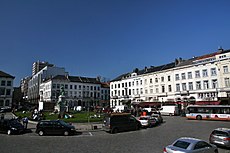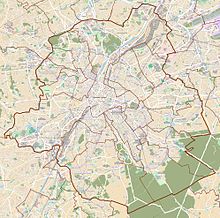
The City of Brussels is the largest municipality and historical centre of the Brussels-Capital Region, as well as the capital of the Flemish Region and Belgium. The City of Brussels is also the administrative centre of the European Union, as it hosts a number of principal EU institutions in its European Quarter.

The Palace of Justice of Brussels or Law Courts of Brussels is a courthouse in Brussels, Belgium. It is the country's most important court building, seat of the judicial arrondissement of Brussels, as well as of several courts and tribunals, including the Court of Cassation, the Court of Assizes, the Court of Appeal of Brussels, the Tribunal of First Instance of Brussels, and the Bar Association of Brussels.

Brussels-Schuman railway station is a railway station in the City of Brussels, Belgium, serving the European Quarter. It received its name from the area around the Robert Schuman Roundabout, itself named after Robert Schuman, one of the founding fathers of the European Union.
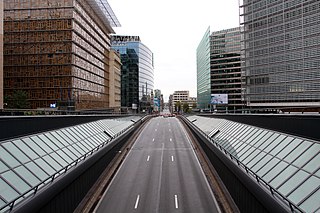
The Rue de la Loi or Wetstraat (Dutch), meaning "Law Street", is a major street running through central and eastern Brussels, Belgium, which is famous due to the presence of several notable Belgian and European Union (EU) governmental buildings. The road runs from the Rue Royale/Koningsstraat, in central Brussels, to the Robert Schuman Roundabout in its European Quarter. It forms the first (westerly) part of the N3 road that runs to Aachen, Germany.

Brussels (Belgium) is considered the de facto capital of the European Union, having a long history of hosting a number of principal EU institutions within its European Quarter. The EU has no official capital but Brussels hosts the official seats of the European Commission, Council of the European Union, and European Council, as well as a seat of the European Parliament. In 2013, this presence generated about €250 million and 121,000 jobs. The main rationale for Brussels being chosen as "capital of the European Union" was its halfway location between France, Germany and the United Kingdom, the three countries whose rivalry played a role in starting the two World Wars and whose reconciliation paved the way for European integration.

The Avenue Louise or Louizalaan (Dutch) is a major thoroughfare in Brussels, Belgium. It is located in the southern part of the City of Brussels, on the border with the municipality of Ixelles, where it runs south–east from the Place Louise/Louizaplein to the Bois de la Cambre/Ter Kamerenbos, covering a distance of 2.7 km (1.7 mi). It is named in honour of King Leopold II's eldest daughter, Princess Louise (1858–1924).
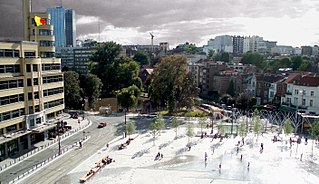
The Place Eugène Flagey or Eugène Flageyplein (Dutch), usually shortened to the Place Flagey, or Flagey by locals, is a square in the Brussels municipality of Ixelles, Belgium. It bears the name of a former mayor of Ixelles, Eugène Flagey.

The Congress Column is a monumental column in Brussels, Belgium, commemorating the creation of the Belgian Constitution by the National Congress of 1830–31. Inspired by Trajan's Column in Rome, it was erected between 1850 and 1859, on the initiative of the then-Prime Minister of Belgium, Charles Rogier, according to a design by the architect Joseph Poelaert. At the top of the column is a statue of Belgium's first monarch; King Leopold I, and at its base, the pedestal is surrounded by statues personifying the four freedoms guaranteed under the Constitution. The Belgian Tomb of the Unknown Soldier with an eternal flame lies at its foot.

The Mont des Arts or Kunstberg, meaning "Hill/Mount of the Arts", is an urban complex and historic site in central Brussels, Belgium, including the Royal Library of Belgium (KBR), the National Archives of Belgium, the Square – Brussels Meeting Centre, and a public garden.
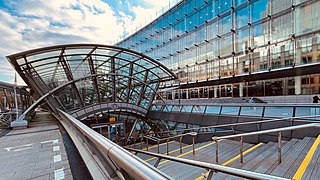
Brussels-Luxembourg railway station is a railway station in the European Quarter of Brussels, Belgium, under the Esplanade of the European Parliament.

The Espace Léopold or Leopoldruimte is the complex of parliament buildings in Brussels, Belgium, housing the European Parliament, a legislative chamber of the European Union (EU). It consists of a number of buildings, primarily the oldest, the Paul-Henri Spaak building, which houses the debating chamber and the President's offices, and the Altiero Spinelli building, which is the largest. The buildings are located in the European Quarter of Brussels, with construction starting in 1989.
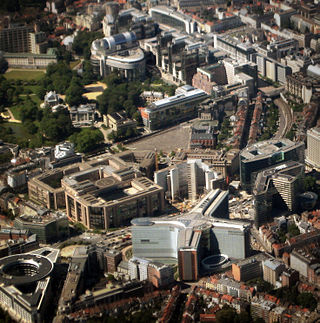
The Leopold Quarter is a quarter of Brussels, Belgium. Today, the term is sometimes confused with the European Quarter, as the area has come to be dominated by the institutions of the European Union (EU) and organisations dealing with them, although the two terms are not in fact the same, with the Leopold Quarter being a smaller more specific district of the municipalities of the City of Brussels, Etterbeek, Ixelles and Saint-Josse-ten-Noode.

The Place Jean Rey is a square in the European Quarter of Brussels, Belgium. It was inaugurated in 2001 and is named after Jean Rey, the second President of the European Commission.

The Convent Van Maerlant is a former convent which consists of a church and the Chapel of the Resurrection on the Rue Van Maerlant/Van Maerlantstraat in Brussels, Belgium. It is named after Jacob van Maerlant, a famous medieval Flemish poet.

The Esplanade of the European Parliament, or simply the Mall, is a pedestrian mall in Brussels, Belgium, completed in 2002. Its most representative parts are the Solidarność 1980 Esplanade and the Simone Veil Agora.

The Place Royale or Koningsplein is a historic neoclassical square in the Royal Quarter of Brussels, Belgium. Modelled after the so-called French royal square and built between 1775 and 1782, according to a plan of the architects Jean-Benoît-Vincent Barré and Gilles-Barnabé Guimard, to replace the former Palace of Coudenberg, it was part of an urban project including Brussels Park.

The Place des Martyrs is a historic square in central Brussels, Belgium. Its current name, meaning "Martyrs' Square", refers to the martyrs of the September Days of the Belgian Revolution of 1830.

The Cinquantenaire Arcade is a memorial arcade in the centre of the Parc du Cinquantenaire/Jubelpark in Brussels, Belgium. The centrepiece is a monumental triple arch known as the Cinquantenaire Arch. It is topped by a bronze quadriga sculptural group with a female charioteer, representing the Province of Brabant personified raising the national flag.

The Place Fontainas (French) or Fontainasplein (Dutch) is a square in central Brussels, Belgium. It was created following the covering of the river Senne (1867–1871). It is named in honour of André-Napoléon Fontainas, a former mayor of the City of Brussels.

The Monument to John Cockerill is a group of statues erected in Brussels, Belgium, in memory of the Belgian-British industrialist John Cockerill, a pioneer of the steel industry and the railways in Belgium in the 19th century, as well as the industrial workers of Belgium.
